Response of Wheat, Maize, and Rice to Changes in Temperature, Precipitation, CO2 Concentration, and Uncertainty Based on Crop Simulation Approaches
Abstract
:1. Introduction
2. Materials and Methods
2.1. Literature Selection and Data Collection
2.2. Descriptive Analysis
2.3. Quantitative Analysis
3. Results
3.1. Distribution of Datasets
3.2. Relationship between Climatic Factors and Crop Yield Changes
3.3. Impact of Adaptation Measures on Crop Yields
3.4. Impact of Climate Models and Time Periods on Crop Yields
3.5. Regression Analysis of the Restricted Dataset
4. Discussion
4.1. Impacts of Future Climate Change on Crop Yields
4.2. Uncertainty in the Assessment of Future Climate Change Impacts
5. Conclusions
Author Contributions
Funding
Data Availability Statement
Conflicts of Interest
References
- Reza, M.S.; Sabau, G. Impact of climate change on crop production and food security in Newfoundland and Labrador, Canada. J. Agric. Food Res. 2022, 10, 100405. [Google Scholar]
- IPCC. Impacts, Adaptation, and Vulnerability; Cambridge University Press: Cambridge, UK, 2022. [Google Scholar]
- Huang, M.; Wang, J.; Wang, B.; Liu, D.L.; Feng, P.; Yu, Q.; Pan, X.; Li, S.; Jiang, T. Dominant sources of uncertainty in simulating maize adaptation under future climate scenarios in China. Agric. Syst. 2022, 199, 103411. [Google Scholar] [CrossRef]
- Li, N.; Yao, N.; Li, Y.; Chen, J.; Liu, D.; Biswas, A.; Li, L.; Wang, T.; Chen, X. A meta-analysis of the possible impact of climate change on global cotton yield based on crop simulation approaches. Agric. Syst. 2021, 193, 103221. [Google Scholar] [CrossRef]
- Abraha, M.G.; Savage, M.J. Potential impacts of climate change on the grain yield of maize for the midlands of Kwazulu-Natal, South Africa. Agric. Ecosyst. Environ. 2006, 115, 150–160. [Google Scholar] [CrossRef]
- Zheng, E.; Qin, M.; Chen, P.; Xu, T.; Zhang, Z. Climate change affects the utilization of light and heat resources in paddy field on the Songnen Plain, China. Agriculture 2022, 12, 1648. [Google Scholar] [CrossRef]
- Saddique, Q.; Liu, D.L.; Wang, B.; Feng, P.; He, J.; Ajaz, A.; Ji, J.; Xu, J.; Zhang, C.; Cai, H. Modelling future climate change impacts on winter wheat yield and water use: A case study in Guanzhong Plain, Northwestern China. Eur. J. Agron. 2020, 119, 126113. [Google Scholar] [CrossRef]
- Lychuk, T.E.; Hill, R.L.; Izaurralde, R.C.; Momen, B.; Thomson, A.M. Evaluation of climate change impacts and effectiveness of adaptation options on crop yield in the Southeastern United States. Field Crops Res. 2017, 214, 228–238. [Google Scholar] [CrossRef]
- Kontgis, C.; Schneider, A.; Ozdogan, M.; Kucharik, C.; Tri, V.P.D.; Duc, N.H.; Schatz, J. Climate change impacts on rice productivity in the Mekong river delta. Appl. Geogr. 2019, 102, 71–83. [Google Scholar] [CrossRef]
- Arunrat, N.; Sereenonchai, S.; Chaowiwat, W.; Wang, C. Climate change impact on major crop yield and water footprint under CMIP6 climate projections in repeated drought and flood areas in Thailand. Sci. Total Environ. 2022, 807, 150741. [Google Scholar] [CrossRef]
- Houma, A.A.; Kamal, M.R.; Mojid, M.A.; Abdullah, A.F.B.; Wayayok, A. Climate change impacts on rice yield of a large-scale irrigation scheme in Malaysia. Agric. Water Manag. 2021, 252, 106908. [Google Scholar] [CrossRef]
- Chisanga, C.B.; Phiri, E.; Chinene, V.R.N.; Chabala, L.M. Projecting maize yield under local-scale climate change scenarios using crop models: Sensitivity to sowing dates, cultivar, and nitrogen fertilizer rates. Food Energy Secur. 2020, 9, e231. [Google Scholar] [CrossRef]
- Wang, B.; Feng, P.; Liu, D.L.; O’Leary, G.J.; Macadam, I.; Waters, C.; Asseng, S.; Cowie, A.; Jiang, T.; Xiao, D.; et al. Sources of uncertainty for wheat yield projections under future climate are site-specific. Nat. Food 2020, 1, 720–728. [Google Scholar] [CrossRef]
- Wallach, D.; Nissanka, S.P.; Karunaratne, A.S.; Weerakoon, W.M.W.; Thorburn, P.J.; Boote, K.J.; Jones, J.W. Accounting for both parameter and model structure uncertainty in crop model predictions of phenology: A case study on rice. Eur. J. Agron. 2017, 88, 53–62. [Google Scholar] [CrossRef]
- Jiang, T.; Wang, B.; Xu, X.; Cao, Y.; Liu, D.L.; He, L.; Jin, N.; Ma, H.; Chen, S.; Zhao, K.; et al. Identifying sources of uncertainty in wheat production projections with consideration of crop climatic suitability under future climate. Agric. For. Meteorol. 2022, 319, 108933. [Google Scholar] [CrossRef]
- Xiong, W.; Asseng, S.; Hoogenboom, G.; Hernandez-Ochoa, I.; Robertson, R.; Sonder, K.; Pequeno, D.; Reynolds, M.; Gerard, B. Different uncertainty distribution between high and low latitudes in modelling warming impacts on wheat. Nat. Food 2019, 1, 63–69. [Google Scholar] [CrossRef] [Green Version]
- Liu, Y.; Li, N.; Zhang, Z.; Huang, C.; Chen, X.; Wang, F. The central trend in crop yields under climate change in China: A systematic review. Sci. Total Environ. 2020, 704, 135355. [Google Scholar] [CrossRef]
- Knox, J.; Daccache, A.; Hess, T.; Haro, D. Meta-analysis of climate impacts and uncertainty on crop yields in Europe. Environ. Res. Lett. 2016, 11, 113004. [Google Scholar] [CrossRef]
- Gurevitch, J.; Koricheva, J.; Nakagawa, S.; Stewart, G. Meta-analysis and the science of research synthesis. Nature 2018, 555, 175–182. [Google Scholar] [CrossRef]
- Osman, R.; Ata-Ul-Karim, S.T.; Tahir, M.N.; Ishaque, W.; Xu, M. Multi-model ensembles for assessing the impact of future climate change on rainfed wheat productivity under various cultivars and nitrogen levels. Eur. J. Agron. 2022, 139, 126554. [Google Scholar] [CrossRef]
- Srivastava, R.K.; Mequanint, F.; Chakraborty, A.; Panda, R.K.; Halder, D. Augmentation of maize yield by strategic adaptation to cope with climate change for a future period in Eastern India. J. Clean. Prod. 2022, 339, 130599. [Google Scholar] [CrossRef]
- Asseng, S.; Ewert, F.; Martre, P.; Rötter, R.P.; Lobell, D.B.; Cammarano, D.; Kimball, B.A.; Ottman, M.J.; Wall, G.W.; White, J.W.; et al. Rising temperatures reduce global wheat production. Nat. Clim. Change 2014, 5, 143–147. [Google Scholar] [CrossRef]
- McGrath, J.M.; Lobell, D.B. Regional disparities in the CO2 fertilization effect and implications for crop yields. Environ. Res. Lett. 2013, 8, 014054. [Google Scholar] [CrossRef] [Green Version]
- Deryng, D.; Elliott, J.; Folberth, C.; Müller, C.; Pugh, T.A.M.; Boote, K.J.; Conway, D.; Ruane, A.C.; Gerten, D.; Jones, J.W.; et al. Regional disparities in the beneficial effects of rising CO2 concentrations on crop water productivity. Nat. Clim. Change 2016, 6, 786–790. [Google Scholar] [CrossRef] [Green Version]
- Kang, X.; Qi, J.; Li, S.; Meng, F.-R. A watershed-scale assessment of climate change impacts on crop yields in Atlantic Canada. Agric. Water Manag. 2022, 269, 107680. [Google Scholar] [CrossRef]
- Ding, Y.; Wang, W.; Zhuang, Q.; Luo, Y. Adaptation of paddy rice in china to climate change: The effects of shifting sowing date on yield and irrigation water requirement. Agric. Water Manag. 2020, 228, 105890. [Google Scholar] [CrossRef]
- Olabanji, M.F.; Ndarana, T.; Davis, N. Impact of climate change on crop production and potential adaptive measures in the olifants catchment, South Africa. Climate 2020, 9, 6. [Google Scholar] [CrossRef]
- Rezaei, E.E.; Siebert, S.; Manderscheid, R.; Müller, J.; Mahrookashani, A.; Ehrenpfordt, B.; Haensch, J.; Weigel, H.-J.; Ewert, F. Quantifying the response of wheat yields to heat stress: The role of the experimental setup. Field Crops Res. 2018, 217, 93–103. [Google Scholar] [CrossRef]
- Ray, D.K.; Gerber, J.S.; MacDonald, G.K.; West, P.C. Climate variation explains a third of global crop yield variability. Nat. Commun. 2015, 6, 5989. [Google Scholar] [CrossRef] [Green Version]
- Raes, D.; Waongo, M.; Vanuytrecht, E.; Mejias Moreno, P. Improved management may alleviate some but not all of the adverse effects of climate change on crop yields in smallholder farms in West Africa. Agric. For. Meteorol. 2021, 308, 108563. [Google Scholar] [CrossRef]
- Cai, C.; Yin, X.; He, S.; Jiang, W.; Si, C.; Struik, P.C.; Luo, W.; Li, G.; Xie, Y.; Xiong, Y.; et al. Responses of wheat and rice to factorial combinations of ambient and elevated CO2 and temperature in face experiments. Glob. Change Biol. 2016, 22, 856–874. [Google Scholar] [CrossRef]
- Prasad, P.V.V.; Boote, K.J.; Allen, L.H.; Sheehy, J.E.; Thomas, J.M.G. Species, ecotype and cultivar differences in spikelet fertility and harvest index of rice in response to high temperature stress. Field Crops Res. 2006, 95, 398–411. [Google Scholar] [CrossRef]
- Wang, J.; Wang, C.; Chen, N.; Xiong, Z.; Wolfe, D.; Zou, J. Response of rice production to elevated [CO2] and its interaction with rising temperature or nitrogen supply: A meta-analysis. Clim. Change 2015, 130, 529–543. [Google Scholar] [CrossRef]
- Aggarwal, P.; Vyas, S.; Thornton, P.; Campbell, B.M. How much does climate change add to the challenge of feeding the planet this century? Environ. Res. Lett. 2019, 14, 043001. [Google Scholar] [CrossRef]
- Xiao, L.; Asseng, S.; Wang, X.; Xia, J.; Zhang, P.; Liu, L.; Tang, L.; Cao, W.; Zhu, Y.; Liu, B. Simulating the effects of low-temperature stress on wheat biomass growth and yield. Agric. For. Meteorol. 2022, 326, 109191. [Google Scholar] [CrossRef]
- Vanuytrecht, E.; Thorburn, P.J. Responses to atmospheric CO2 concentrations in crop simulation models: A review of current simple and semicomplex representations and options for model development. Glob. Change Biol. 2017, 23, 1806–1820. [Google Scholar] [CrossRef]
- Vanuytrecht, E.; Raes, D.; Willems, P.; Geerts, S. Quantifying field-scale effects of elevated carbon dioxide concentration on crops. Clim. Res. 2012, 54, 35–47. [Google Scholar] [CrossRef] [Green Version]
- Garofalo, P.; Ventrella, D.; Kersebaum, K.C.; Gobin, A.; Trnka, M.; Giglio, L.; Dubrovsky, M.; Castellini, M. Water footprint of winter wheat under climate change: Trends and uncertainties associated to the ensemble of crop models. Sci. Total Environ. 2019, 658, 1186–1208. [Google Scholar] [CrossRef]
- Wilcox, J.; Makowski, D. A meta-analysis of the predicted effects of climate change on wheat yields using simulation studies. Field Crops Res. 2014, 156, 180–190. [Google Scholar] [CrossRef]
- Araya, A.; Hoogenboom, G.; Luedeling, E.; Hadgu, K.M.; Kisekka, I.; Martorano, L.G. Assessment of maize growth and yield using crop models under present and future climate in Southwestern Ethiopia. Agric. For. Meteorol. 2015, 214, 252–265. [Google Scholar] [CrossRef]
- Kassie, B.T.; Van Ittersum, M.K.; Hengsdijk, H.; Asseng, S.; Wolf, J.; Rötter, R.P. Climate-induced yield variability and yield gaps of maize (Zea mays L.) in the central rift valley of Ethiopia. Field Crops Res. 2014, 160, 41–53. [Google Scholar] [CrossRef]
- Müller, C.; Franke, J.; Jägermeyr, J.; Ruane, A.C.; Elliott, J.; Moyer, E.; Heinke, J.; Falloon, P.D.; Folberth, C.; Francois, L.; et al. Exploring uncertainties in global crop yield projections in a large ensemble of crop models and CMIP5 and CMIP6 climate scenarios. Environ. Res. Lett. 2021, 16, 034040. [Google Scholar] [CrossRef]
- Asseng, S.; Ewert, F.; Martre, P.; Rötter, R.P.; Lobell, D.B.; Cammarano, D.; Kimball, B.A.; Ottman, M.J.; Wall, G.W.; White, J.W.; et al. Uncertainty in simulating wheat yields under climate change. Nat. Clim. Change 2014, 3, 827–832. [Google Scholar] [CrossRef] [Green Version]
- Zhang, H.; Zhou, G.; Liu, L.; Wang, B.; Xiao, D.; He, L. Climate-associated rice yield change in the Northeast China plain: A simulation analysis based on CMIP5 multi-model ensemble projection. Sci. Total Environ. 2019, 666, 126–138. [Google Scholar] [CrossRef]
- Zhang, Z.; Li, Y.; Chen, X.; Wang, Y.; Niu, B.; Liu, D.L.; He, J.; Pulatov, B.; Hassan, I.; Meng, Q. Impact of climate change and planting date shifts on growth and yields of double cropping rice in Southeastern China in future. Agric. Syst. 2023, 205, 103581. [Google Scholar] [CrossRef]
- Muller, C.; Cramer, W.; Hare, W.L.; Lotze-Campen, H. Climate change risks for african agriculture. Proc. Natl. Acad. Sci. USA 2011, 108, 4313–4315. [Google Scholar] [CrossRef]
- Challinor, A.; Wheeler, T.; Garforth, C.; Craufurd, P.; Kassam, A. Assessing the vulnerability of food crop systems in Africa to climate change. Clim. Change 2007, 83, 381–399. [Google Scholar] [CrossRef] [Green Version]
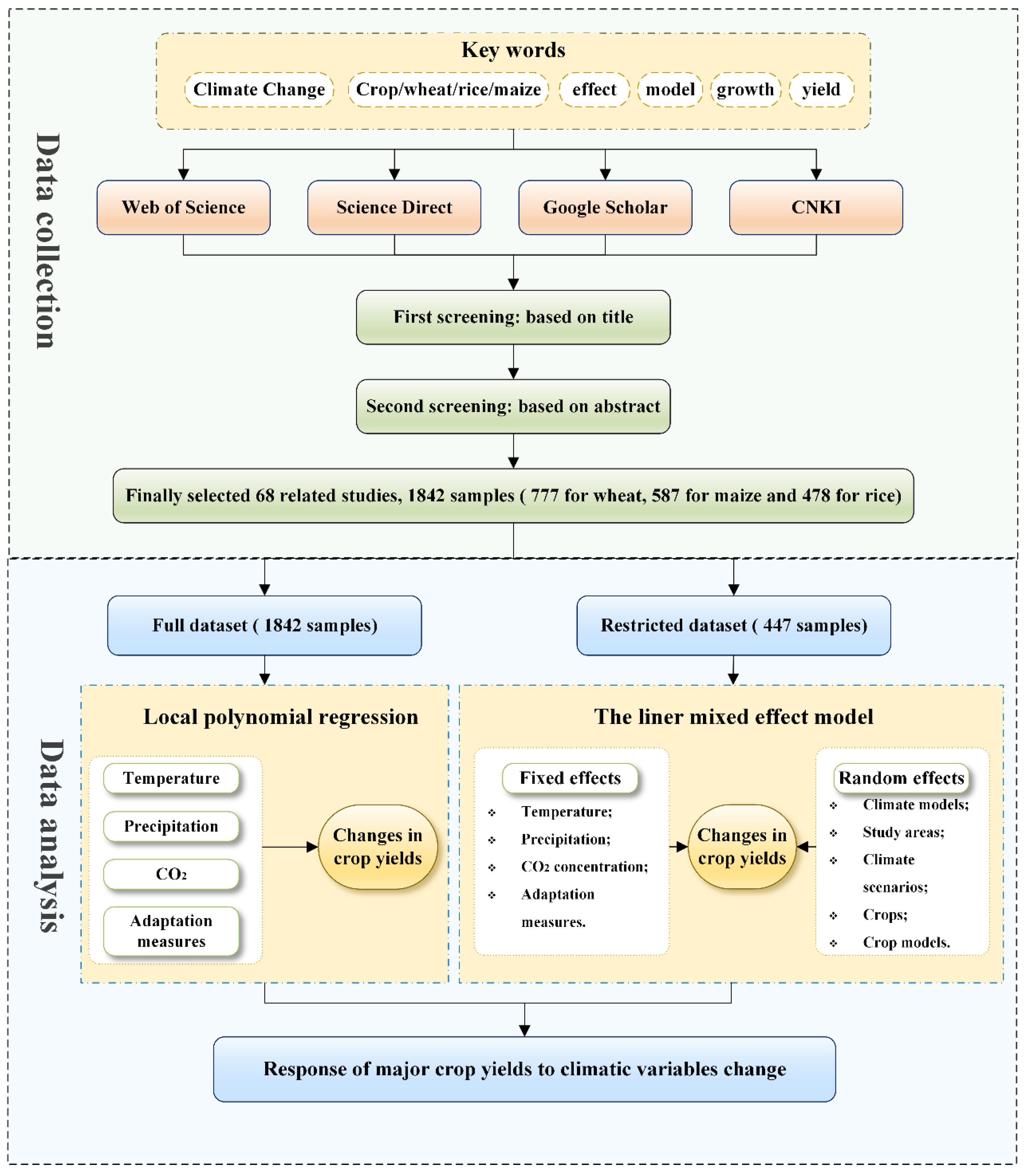
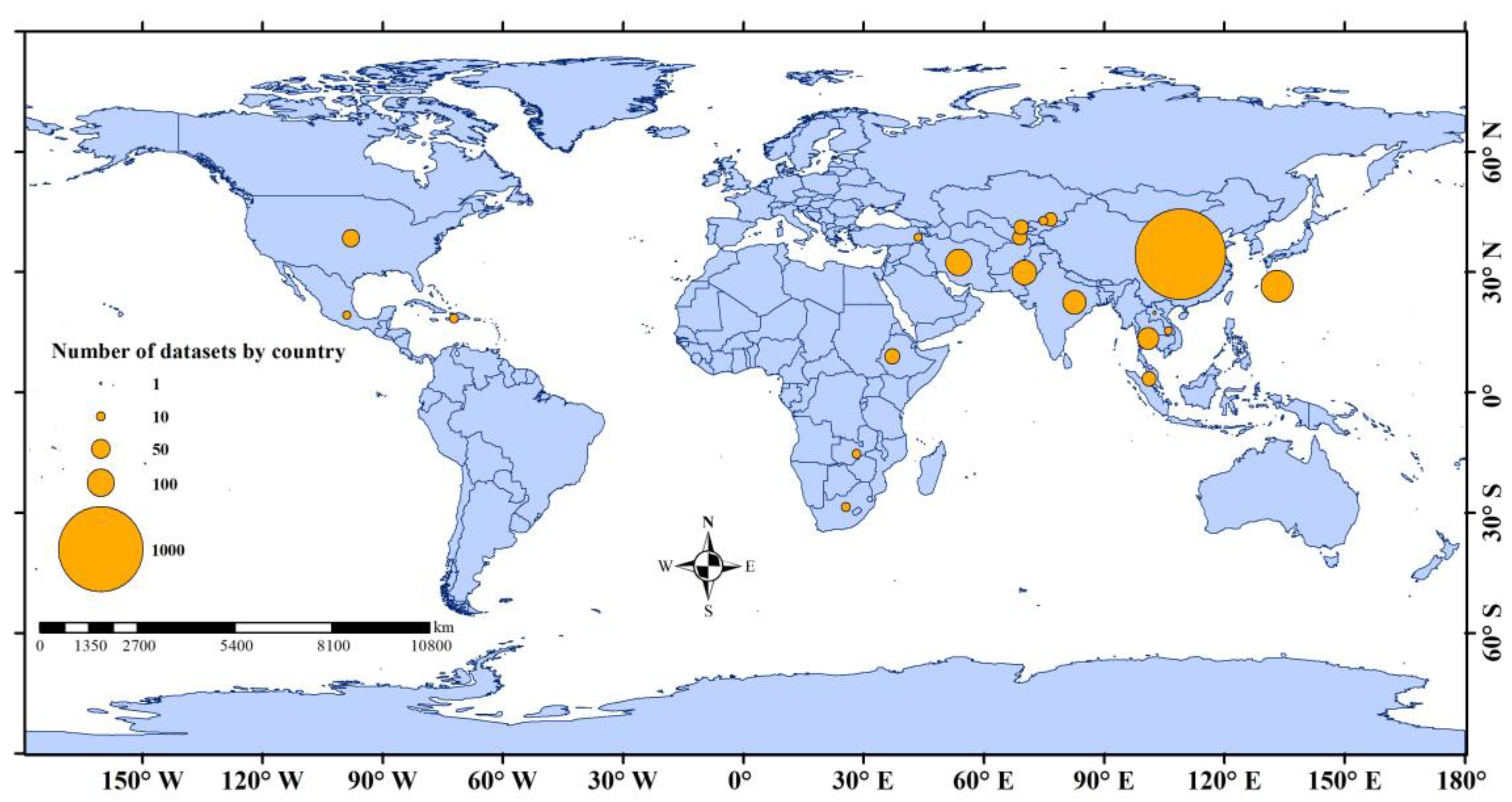
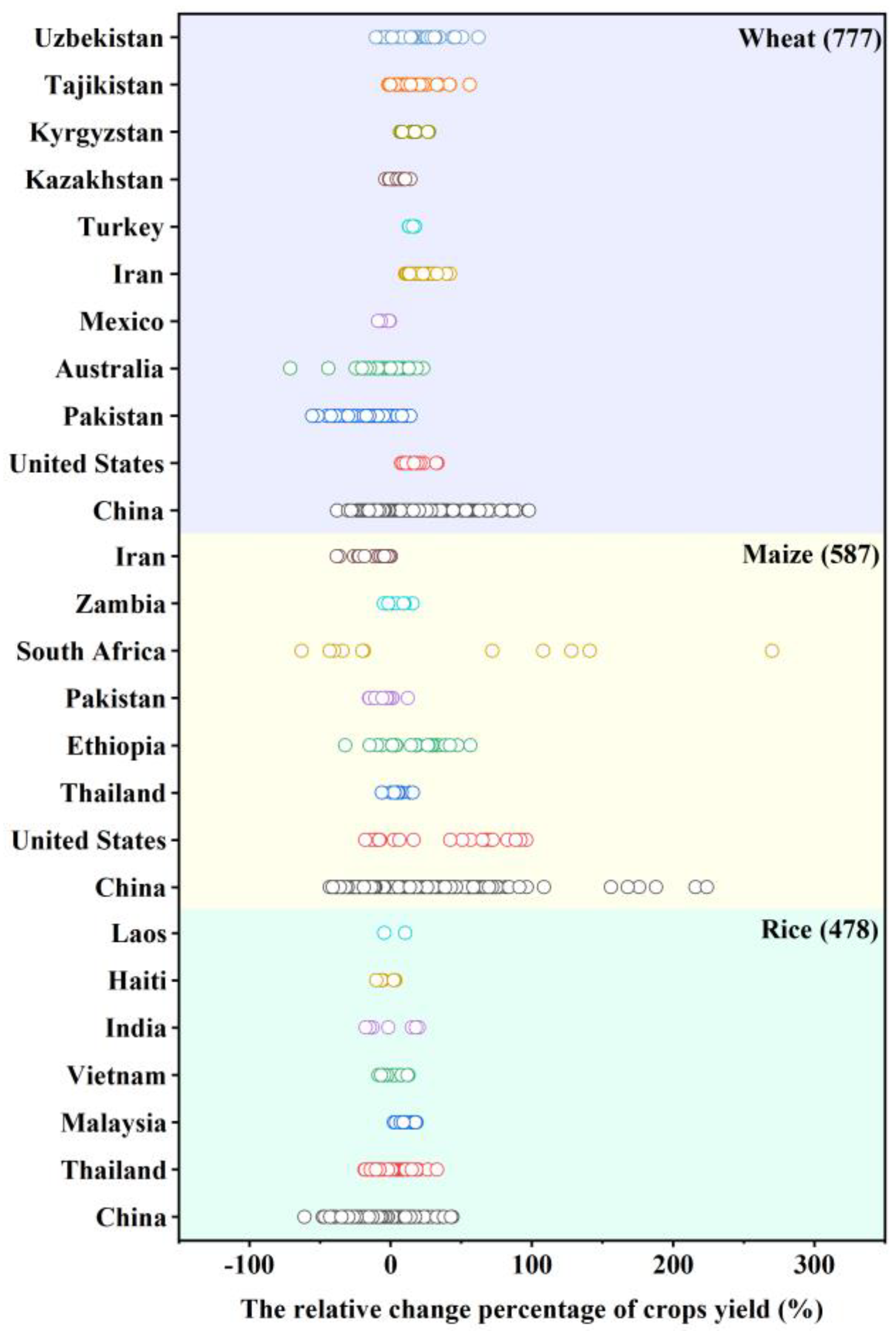


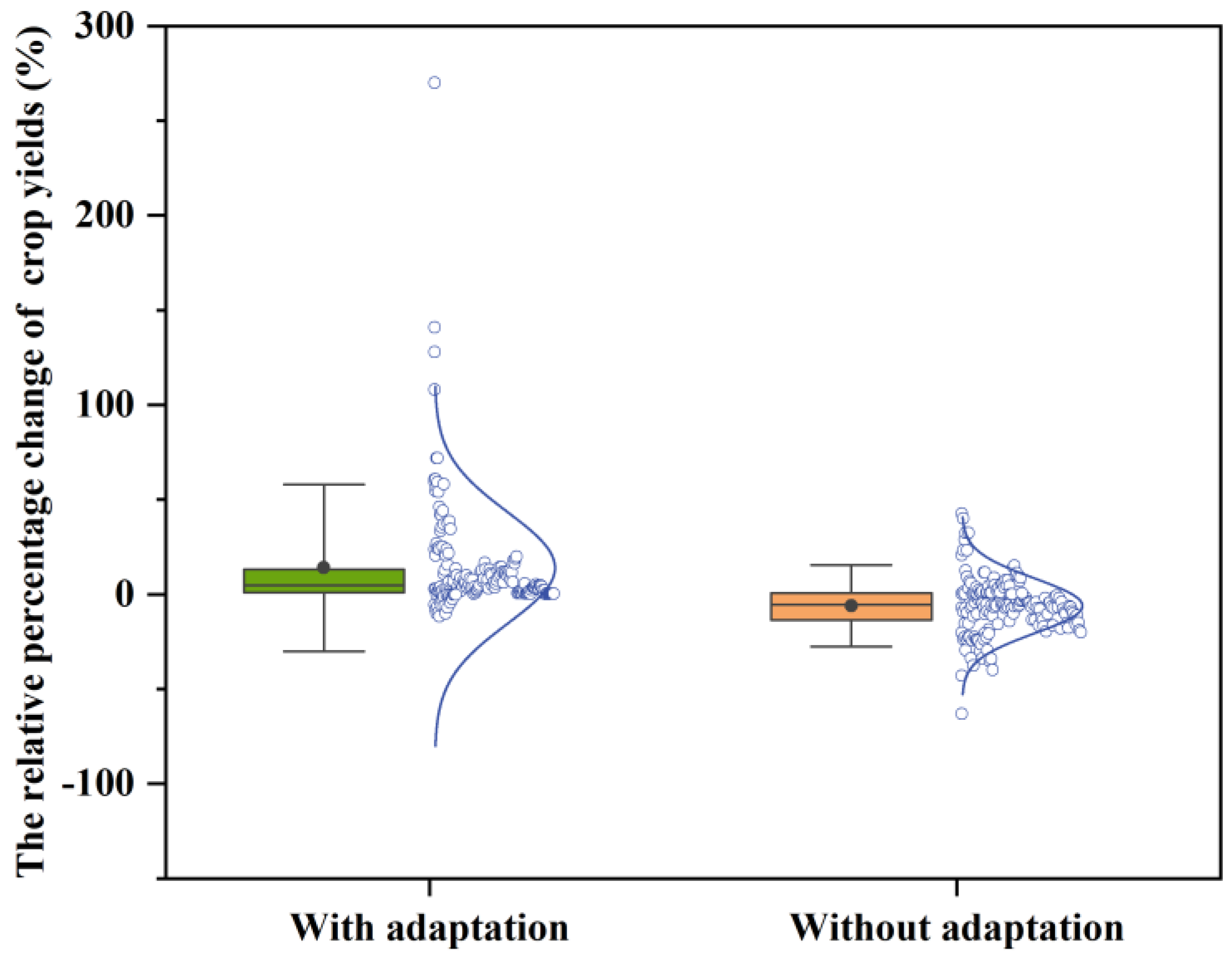

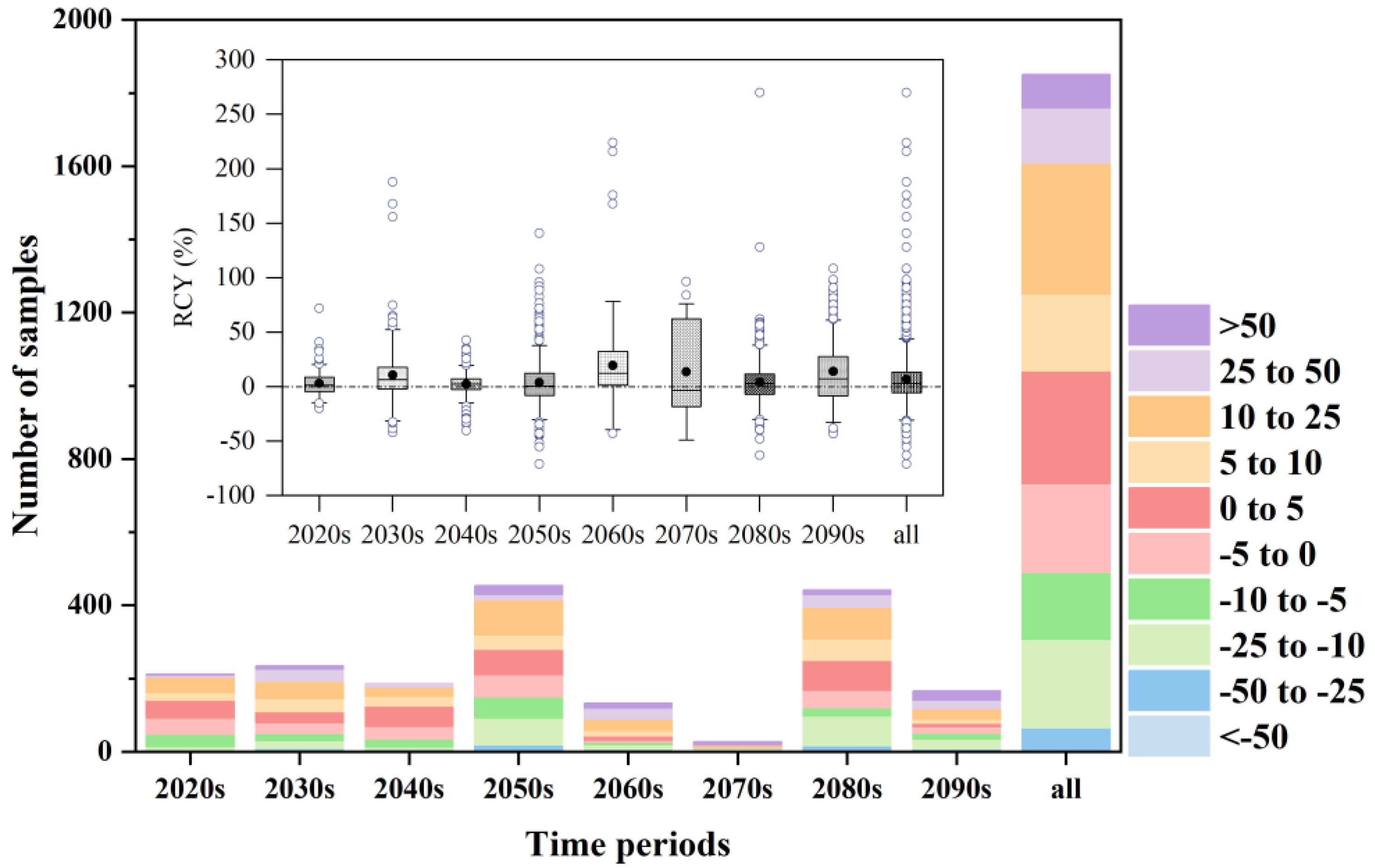
| Country | Minimum | Mean | Maximum | Student’s t Test | ||
|---|---|---|---|---|---|---|
| p Value | S/NS | |||||
| Wheat | Uzbekistan | −10.37 | 20.06 | 62.28 | <0.001 | S |
| Tajikistan | −1.54 | 14.59 | 55.93 | <0.001 | S | |
| Kyrgyzstan | 6.70 | 15.18 | 27.27 | <0.001 | S | |
| Kazakhstan | −3.69 | 4.89 | 14.13 | <0.001 | S | |
| Turkey | 12.94 | 15.16 | 17.25 | <0.001 | S | |
| Iran | 10.50 | 20.32 | 41.91 | <0.001 | S | |
| Mexico | −8.74 | −4.55 | −0.50 | 0.008 | S | |
| Australia | −71.00 | −0.70 | 22.96 | 0.444 | NS | |
| Pakistan | −55.41 | −12.90 | 14.10 | <0.001 | S | |
| United States | 7.60 | 16.38 | 33.10 | <0.001 | S | |
| China | −37.85 | 8.89 | 98.10 | <0.001 | S | |
| All | −55.41 | 6.66 | 98.10 | <0.001 | S | |
| Maize | Iran | −38.10 | −6.88 | 0.20 | <0.001 | S |
| Zambia | −4.65 | 3.28 | 15.48 | 0.155 | NS | |
| South Africa | −63.00 | 47.67 | 270.00 | 0.132 | NS | |
| Pakistan | −15.20 | −4.54 | 12.13 | 0.015 | S | |
| Ethiopia | −32.17 | 13.73 | 56.58 | <0.001 | S | |
| Thailand | −6.30 | 4.10 | 15.79 | 0.053 | NS | |
| United States | −18.00 | 29.58 | 96.07 | 0.002 | S | |
| China | −43.03 | 10.23 | 224.00 | <0.001 | S | |
| All | −63.00 | 10.02 | 270.00 | <0.001 | S | |
| Rice | Laos | −4.30 | 3.00 | 10.30 | 0.752 | NS |
| Haiti | −10.00 | −3.42 | 3.35 | 0.032 | S | |
| India | −17.67 | 1.27 | 20.00 | 0.800 | NS | |
| Vietnam | −8.59 | 0.47 | 12.60 | 0.816 | NS | |
| Malaysia | 2.41 | 11.36 | 18.49 | <0.001 | S | |
| Thailand | −18.50 | 2.18 | 32.99 | 0.182 | NS | |
| China | −60.91 | −2.62 | 43.90 | <0.001 | S | |
| All | −60.91 | −1.49 | 43.90 | 0.005 | S | |
| Fixed Effect | Random Effect | ||||||
|---|---|---|---|---|---|---|---|
| Variable | Coefficient | t Value | p | Variable | Estimate | z Value | p |
| −4.21 | −2.48 | 0.013 * | Study areas | 172.68 | 2.70 | 0.007 ** | |
| 1.03 | 0.57 | 0.571 | Crops | 177.26 | 0.97 | 0.332 | |
| 0.43 | 6.71 | <0.001 *** | Crop models | 10.28 | 0.34 | 0.731 | |
| 0.02 | 1.54 | 0.125 | Climate models | 173.64 | 2.00 | 0.046 * | |
| A (no = 0; yes = 1) | 64.09 | 4.78 | <0.001 *** | Climate scenarios | 19.81 | 1.59 | 0.112 |
| Intercept | 69.73 | 4.75 | <0.001 *** | Residual | 191.27 | 13.76 | |
Disclaimer/Publisher’s Note: The statements, opinions and data contained in all publications are solely those of the individual author(s) and contributor(s) and not of MDPI and/or the editor(s). MDPI and/or the editor(s) disclaim responsibility for any injury to people or property resulting from any ideas, methods, instructions or products referred to in the content. |
© 2023 by the authors. Licensee MDPI, Basel, Switzerland. This article is an open access article distributed under the terms and conditions of the Creative Commons Attribution (CC BY) license (https://creativecommons.org/licenses/by/4.0/).
Share and Cite
Qin, M.; Zheng, E.; Hou, D.; Meng, X.; Meng, F.; Gao, Y.; Chen, P.; Qi, Z.; Xu, T. Response of Wheat, Maize, and Rice to Changes in Temperature, Precipitation, CO2 Concentration, and Uncertainty Based on Crop Simulation Approaches. Plants 2023, 12, 2709. https://doi.org/10.3390/plants12142709
Qin M, Zheng E, Hou D, Meng X, Meng F, Gao Y, Chen P, Qi Z, Xu T. Response of Wheat, Maize, and Rice to Changes in Temperature, Precipitation, CO2 Concentration, and Uncertainty Based on Crop Simulation Approaches. Plants. 2023; 12(14):2709. https://doi.org/10.3390/plants12142709
Chicago/Turabian StyleQin, Mengting, Ennan Zheng, Dingmu Hou, Xuanchen Meng, Fanxiang Meng, Yu Gao, Peng Chen, Zhijuan Qi, and Tianyu Xu. 2023. "Response of Wheat, Maize, and Rice to Changes in Temperature, Precipitation, CO2 Concentration, and Uncertainty Based on Crop Simulation Approaches" Plants 12, no. 14: 2709. https://doi.org/10.3390/plants12142709





